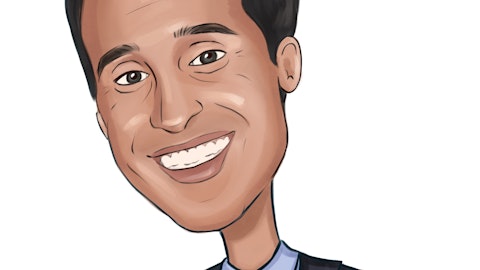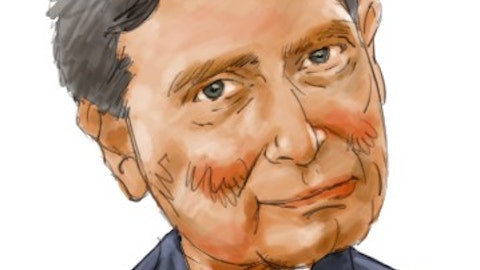Seth Basham : Thanks a lot and good morning. My question is on the margin outlook for 2024. Hoping for some more color between expectations for gross margins and SG&A. It seems like you expect the total gross margin improvement probably from commodities, but what about from improved operational efficiency? Commodities, but what about from improved operational efficiency? And on the SG&A side it seems like advertising growth is likely to be about in line with sales growth, but are you expecting deleverage and other costs? Thank you.
Bhaskar Rao: Scott, you want me to that up?
Scott Thompson: Yes. You go ahead.
Bhaskar Rao: So on a gross profit perspective good call out Seth. It would be our expectation is that we would see nice year-on-year improvement from gross margin. So a couple of big drivers I would call out. I spoke to commodities briefly in the prior question. We would expect that to be a tailwind. We’re very excited about the continuing momentum that we see in our US operations, just to put a reference on that. We invested in customers and spilled some EBITDA historically. We started seeing the benefits of that starting to turn around in the back half of 2023. The expectation is that that would continue to build momentum as we get into 2024. So that would be a tailwind for us as well. Previously, I think, I mentioned something around $50 million to $60 million.
It would be our expectation that that would continue. On a year-on-year basis, yes, there’s some phasing between quarters as it relates to launch. But big picture floor model should be a slight tailwind for us versus the prior year. And then Crawfordsville would be a headwind. So when I think about that Crawfordsville, again, a headwind on rate. However, if Crawfordsville was not there it would be difficult for us to manage this new distribution wins that we would have without incurring over time and with our various other facilities. So that’s really the gross profit story. As I think about from an operating expense perspective, a couple of things, is we continue to manage this business for long-term growth. So we’re going to invest in those things that will give us that growth and outlook perspective.
When you think about OpEx on an overall basis is that we would expect just a bit of deleverage. On the advertising perspective just parsing that out is I would think of the North American business being flat on rate on a year-over-year basis. And internationally, we’re going to invest to really support that growing into that new addressable market. So what that blends to when you put all that together we expect incremental investments on rate from advertising. Also we continue to be very excited about the potential of our direct-to-consumer business not only in the bricks and mortar which is a global story. In fact our brick — the doors on a year-over-year basis from first quarter to first quarter have grown 40 million – sorry, around 40 stores.
So we’re going to continue to invest in that initiative as well as the e-comm. As you know we have a robust e-commerce business in the US and now all of our brands are represented Stearns, Sealy as well as Tempur. And then we spoke to international, but just parsing that a bit as China remains a big opportunity for us. So we’re going to spend some money there. So really what’s again flat to slightly up as it relates to rate from an OpEx perspective. But really what’s driving it is the investments we’re making in future growth.
Operator: One moment for our next question. Our next question will be coming from Brad Thomas of KeyBanc Capital Markets. Your line is open, Brad.
Brad Thomas: Hi. Good morning. I was hoping we could talk a little bit more about the international segment. And perhaps a bit more about the outlook for new product rollouts and some of the timing of some of the margin opportunities that you have as we look forward? Thanks..
Scott Thompson: Sure. I’ll talk a little bit about the international rollout. It’s gone really well. And I think it’s just probably the beginning from the international standpoint. And you can see from I think Bhaskar’s earlier comments about what we’re doing from an advertising standpoint we feel we’ve got the right product now at the right price points. We’re spending a little more money in advertising because we think the returns are going to be good. But all that is a very bullish sign for international on a — we’ll call it a multiyear strategy. It’s taken us quite a while quite a number of years to get the product get it right get the manufacturing process right. But we think we’re in the early innings from an international growth standpoint. Bhaskar, do you want to add anything?
Bhaskar Rao: What I would say from timing of a margin view is as I think about gross margin is, we mentioned the typical seasonality. We’re not going to see that necessarily this year just given as we ramp into that new distribution and given Crawfordsville from a gross margin expectation standpoint again overall up year-on-year. And then margins consistent with prior years is that, it would increase as we go throughout the year really been driven by a couple of different items. One is that, we do expect from a growth standpoint sales growth more in the back half than we would in the first half, therefore, giving us some leverage from a gross margin on the gross margin line, and as well as those as the operational improvements is that will gain momentum and continue to build on itself.
Brad Thomas: Great. Thank you very much.
Operator: One moment for our next question. Our next question will be coming from Michael Lasser of UBS. Your line is open, Michael.
Michael Lasser: Good morning. Thank you so much for taking my question. How do you think about the incremental margin on either sales upside or potential downside as the year unfolds? And into next year assuming that the bedding recovery continues to gain steam? Thank you so much.
Scott Thompson: Okay. I’m going to speak for a second and then will let Bhaskar answer it. It’s interesting. It’s a really interesting question. On the upside, it’s obviously good. I think the part, I want to call out is, on the downside, if for some reason we’ve missed our call on the industry, we’ve got a lot of flexibility in the system to take cost out, because we’ve got the company positioned I’m going to call it aggressively for growth. And when you position a company aggressively for growth there you’re spending some money as we’ve talked about earlier in this call. And if for some reason there was a downside case someone was working with we have the ability to take out a good bit of cost, if we reposition the company for that kind of environment that we don’t see. Do you want to talk about that a little bit Bhaskar?
Bhaskar Rao: Absolutely. What I would say on a blended basis the way I’ve historically thought about this business the incremental contribution profit call it is somewhere between 30% to 35%. As I sit here today, it feels closer to 35% maybe a bit above that versus where we have been historically. And that in context is all things being equal. As we pointed out, we have expectations about the category. And as the consumer starts coming back and they will bedding is not going obsolete mattresses are not going obsolete. There will be a mix of when those units come back. Again, positive from an EBITDA standpoint positive from a contribution profit standpoint. However, that mix would be something to think about as this industry begins to recover.
Michael Lasser: Thank you so much.
Operator: Our next question will be coming from Keith Hughes of Truist. Keith, your line is open.
Keith Hughes: Thank you. A question on the new facility in Indiana. Once you get up to full capacity, how much of your pouring will that represent? And will you actually hit full capacity in the second quarter?
Scott Thompson: Really complicated question. Let me put some words around it. No, we will not hit full capacity in the second quarter. And it depends on when you talk about capacity, whether you’re running one shift, two shifts all that kind of stuff. The way you should probably think about it is look first quarter a little bit of a drag to get it going by the time you’re into the second and third quarter, Crawfordsville is contributing, okay? But you should think about optimize — optimized it’s probably a couple of years out as far as being totally optimized depending on what the bedding market is and it gives us great flexibility. But we’ve — with Crawfordsville and the other plants we have and the ability to go to second shifts, you should think about Tempur has capacity for the foreseeable future, both in pouring OEM foam and regular foam.
Keith Hughes: Okay. One follow-up question to that.
Scott Thompson: Go ahead.
Keith Hughes: Do you think you’re going to — in terms of like spring production, do you think you’ll do some more backward integration on spring production in the future as well? Particularly, given the volume you’re starting to move in the industry?





